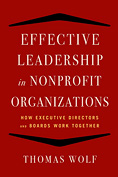 ... blogpost7" />
... blogpost7" />
Case Studies from Effective Leadership for Nonprofit Organizations
![[Image: Book cover]](http://172.104.216.14/wp-content/uploads/books_reports/effective.jpg) Thomas Wolf writes: “This is the seventh blog post drawn from my book, Effective Leadership for Nonprofit Organizations: How Executive Directors and Boards Work Together. This one is called: “So You Want a Good Board President?” It offers insights on the Executive Director’s possible role in identifying and selecting Board leadership.
Thomas Wolf writes: “This is the seventh blog post drawn from my book, Effective Leadership for Nonprofit Organizations: How Executive Directors and Boards Work Together. This one is called: “So You Want a Good Board President?” It offers insights on the Executive Director’s possible role in identifying and selecting Board leadership.
Tim had been executive director of a successful nonprofit organization for just over two years when the organization elected a new president, someone Tim did not know well but who was highly respected in the community. They agreed to meet once a week for the first few months of his tenure until they got better acquainted and had shared ideas about key issues and actions that needed to be taken up by the board.
It was during one of these early meetings that the new president asked Tim, “Who is going to be your next board president after me?”
“I have no idea,” Tim said. “You were just elected. Presumably the board has years to decide. Besides, in this organization, the vice president usually becomes president, so we are covered.”
“A bad idea,” he said. “Is he someone you want to be your next president?”
“No,” Tim confided. “He is not particularly strong as a leader, not much of a donor, and hates asking for money. But he has been a loyal volunteer and people like him and feel he should be rewarded.”
“Okay,” said the new president. “Let’s get started and find you a better one.”
The two went over the board list. Tim confided that he didn’t see anyone among the officers or the other trustees who he felt was presidential material and who, just as importantly, would likely accept the position. “Exactly,” said the president. “Just what I figured. You confirmed my suspicions. That is why we are talking about it now. We have to go out and find a president. That will take time. We will need to bring that person on to the board, test him or her out on a committee or two, eventually get that individual onto the executive committee, and then into an officer position. That can take years. And what if that person doesn’t work out? We will need time to recruit someone else. You should ALWAYS be thinking about your next president and providing your candidate with the proper training to make sure that person succeeds and will be loyal to you in the process.”
During the next several years, Tim also learned that assessing trustee performance was one of his most important jobs, one that was not in his job description but something his president expected him to do. The president taught Tim the trick of using committee assignments as a testing group. “Jana has been complaining about how haphazard our trustee fundraising has been. She says we could raise a lot more money if we were better organized. I have put her on the development committee. Let’s see just how good she is at trustee asks.” As it happened, Jana was quite good and soon found herself an officer of the corporation.
–© Thomas Wolf, from Effective Leadership for Nonprofit Organizations: How Executive Directors and Boards Work Together, Allworth Press, 2013. For single copies, go to amazon.com. For information on discounts on multiple copy orders, email or call Jane@WolfBrown.com (617-494-9300).
